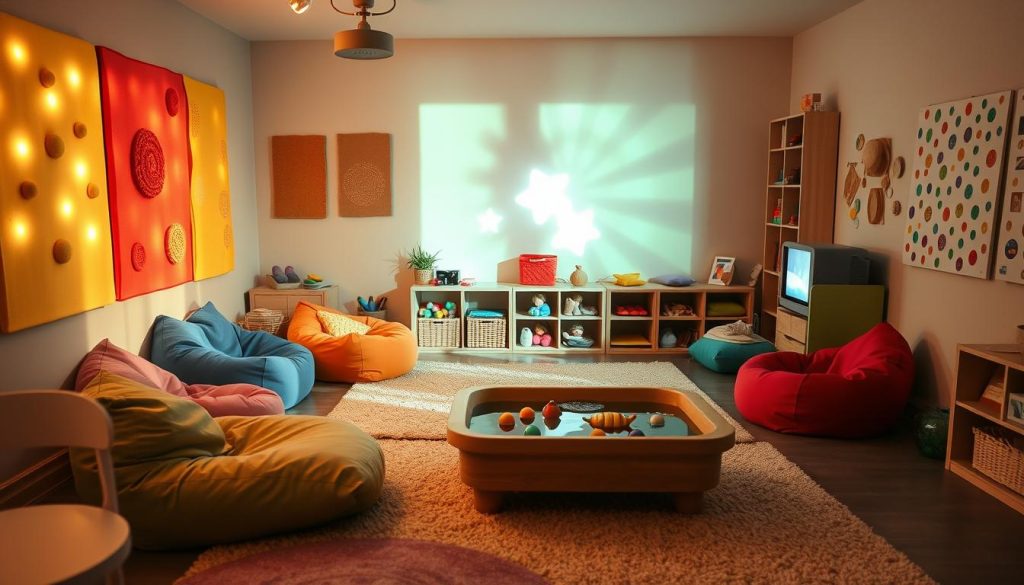Many people with Autism spectrum disorder (ASD) face special challenges every day. These challenges include sensory integration issues. Their brains process sensory information differently than others.
Sensory challenges in autism can show up in many ways. It affects how they see, hear, and feel their surroundings. Some might feel things too strongly, while others might not feel them enough. This can lead to behaviors that seem strange to others.
It’s key to tackle sensory challenges in autism because they play a big role in how people with ASD learn and connect. Understanding these sensory issues helps us create a more welcoming world. It also helps us find ways to support their growth and happiness.
Understanding Autism and Sensory Processing
Autism spectrum disorder (ASD) is closely linked to how we process sensory information. This leads to unique sensory experiences for each person. Experts from the American Psychiatric Association and the Sensory Processing Disorder Foundation stress the need to differentiate between sensory processing disorder (SPD) and sensory issues in children with autism.
Sensory issues in children with autism can affect many areas of life. This includes social interactions and educational success. While autism does not automatically mean a child has SPD, the similar symptoms in both conditions highlight the need for specific intervention strategies.
Here’s how these sensory issues might show up:
- Being too sensitive to sensory stimuli (like finding noises too loud or textures too irritating)
- Being less sensitive (showing little or no reaction to temperature or pain)
- Craving sensory experiences too much (like touching objects or people too much)
It’s important to understand the differences between autism spectrum disorder sensory issues and sensory processing disorder. While SPD can happen alone, its connection to autism means we need a support plan that addresses all sensory integration challenges.
Defining Autism Spectrum Disorder Sensory Issues
Autism Spectrum Disorder (ASD) brings unique challenges, mainly in how it handles sensory information. People with ASD often feel too much sensory input, leading to sensory overload. This can greatly impact their daily life and happiness.
Sensory issues in children with autism are not just about being too sensitive. They can also be very unaware of their surroundings, which can be dangerous and affect their social skills.
The Five Senses and Autism
Autism can affect each sense differently. Some might find sounds too loud, lights too bright, or touches too much. Taste and smell can also cause problems, making everyday interactions hard.
Types of Sensory Issues in Autism
- Sensory sensitivity – even small sounds, smells, or changes in lighting can feel intense.
- Sensory avoidance – avoiding sensory experiences, like not wanting physical contact or certain food textures.
- Sensory seeking – needing more sensory input, like craving touch or preferring loud places.
Differences Between Sensory Processing Disorder and Autism
| Aspect | Sensory Processing Disorder (SPD) | Autism Spectrum Disorder (ASD) |
|---|---|---|
| Focus on Sensory Issues | Primary symptom is difficulty in processing sensory information. | One of several symptoms including social communication challenges and repetitive behaviors. |
| Response to Sensory Input | May exhibit sensory seeking or avoiding behaviors. | Responses can include sensory overload in autism leading to meltdowns. |
| Diagnosis | Not recognized as a separate medical condition; often considered within the scope of other developmental disorders. | Widely recognized developmental disorder with established diagnostic criteria. |
While both conditions deal with sensory challenges, their treatments and approaches can differ. Getting the right diagnosis is key for proper support and management.
Causes of Sensory Integration Challenges in Autism
The study of sensory integration in autism is growing. It shows how brain and environment work together. This starts with the brain’s role in autism spectrum disorder sensory issues.
Research points to brain differences in how we process sensory info. The Journal of Autism and Developmental Disorders sheds light on this. It says brain region delays can mess up how we handle our surroundings.
But it’s not just the brain. The National Institute of Neurological Disorders and Stroke (NINDS) talks about how too much stimulation can worsen these issues. This can make people on the autism spectrum more sensitive or avoid certain situations.
| Factor | Impact on Sensory Integration |
|---|---|
| Neurological Variations | Alterations in brain connectivity and development affect how sensory stimuli are processed. |
| Environmental Stimuli | Overstimulating environments can exacerbate sensory processing issues, leading to sensory overload or avoidance behaviors. |
In conclusion, sensory integration challenges in autism are complex. They involve brain differences and how we interact with our environment. Knowing this helps us find ways to manage autism spectrum disorder sensory issues.
Identifying Sensory Challenges in Children with Autism
Sensory challenges in autism can greatly affect a child’s life. It’s important to spot these issues early and accurately. This means knowing the signs and using the right tools for assessment.
Behavioral Signs of Sensory Sensitivity
Children with autism may react differently to sensory inputs. These reactions can show if they face sensory challenges. For example, they might get upset by sounds, textures, lights, or smells that others find okay.
They might also do repetitive actions like rocking or hand-flapping when feeling overwhelmed. Other signs include trouble focusing, outbursts, or clinging to certain textures. These are early signs of discomfort that might not be spoken out loud.
Assessment Tools for Sensory Issues
Professionals use various tools to check for sensory issues in kids with autism. The Sensory Profile is a key tool for this. It helps occupational therapists create specific plans for therapy.
| Assessment Tool | Description | Usage |
|---|---|---|
| Sensory Profile | A set of standardized questionnaires designed to assess children’s sensory processing abilities and responsiveness. | Widely used by occupational therapists to identify sensory challenges and plan appropriate therapies. |
| Behavioral Observations | Systematic monitoring of responses to sensory stimuli in various environments. | Helps to contextualize the sensory profile within real-life situations and tailor interventions. |
By spotting the signs and using the right tools, we can help kids with autism. This way, we make their lives better by meeting their unique sensory needs.
Autism Spectrum Disorder Sensory Issues
It’s important to understand sensory issues in children with autism. These challenges vary a lot from person to person. Each child with autism has their own unique struggles.
Sensory processing disorder often goes hand in hand with autism. This makes it hard for kids to handle their surroundings. These problems can affect their social life, school work, and happiness.
- Hyper-sensitivity to sounds may lead to distress in noisy environments
- Tactile sensitivity can make everyday clothing feel uncomfortable
- Visual or olfactory sensitivities that make bright lights or strong smells particular overwhelming
These sensory issues can cause behaviors that seem like problems. But they’re really how kids with autism react to too much stimulation. It’s vital to help them with the right strategies and places.
It’s key to tailor help and support to each child’s unique needs. This way, they can feel more at ease in their world.

Creating special activities can help. These activities should reduce the chance of feeling overwhelmed. This lets kids enjoy different places more and with less stress.
Knowing about the wide range of sensory issues helps us create better help. It also makes places more welcoming and supportive for kids with autism.
Treatment for Sensory Issues in Autism
Dealing with sensory issues in autism needs a full plan. This includes different therapies and making the environment more friendly. We will look at how therapy works, why a friendly environment is key, and how parents can help.
Therapeutic Approaches to Sensory Challenges
Sensory integration therapy is a great way to tackle sensory problems in autism. Occupational therapists created it. It helps people deal with too much sensory input.
These sessions use exercises that mix up the senses. This helps the brain handle sensory information better.
Creating a Sensory-Friendly Environment
A sensory-friendly environment is very important for people with autism. It can have soft lights, less noise, and quiet spots. These changes help people feel less stressed.
Changing your home to include quiet areas or sensory rooms can really help. It makes daily life easier by controlling sensory inputs.
Parent-Driven Strategies for Managing Sensory Sensitivity
Parents can use many ways to help with sensory issues. Routines make things more predictable. Sensory toys or weighted blankets can be calming.
Also, activities like swimming can be good. They mix sensory experiences in a way that’s easy to handle.
| Strategy | Description | Benefits |
|---|---|---|
| Sensory Integration Therapy | Therapeutic activity led by professionals to help manage sensory input. | Improves sensory processing, enhances coordination and balance. |
| Sensory-friendly Modifications | Adjustments made within living or educational environments. | Reduces sensory overload, increases comfort and functional use of space. |
| Parental Engagement | Activities and routines designed by parents to help manage daily sensory challenges. | Promotes stability, enhances coping skills, strengthens parent-child interaction. |
Impact of Sensory Sensitivity on Daily Life
Sensory sensitivity greatly affects daily life for people with autism. It impacts simple tasks and complex social interactions. Understanding sensory challenges in autism is key to creating supportive environments.
For many, sensory sensitivity makes public places too much to handle. Places with bright lights or loud noises can be overwhelming. This makes going out, like shopping, a big stress.
- Personal care routines, like brushing hair or teeth, can be uncomfortable or painful.
- Classrooms are too busy for students with sensory challenges, making it hard to learn.
- Understanding social cues is tough, leading to anxiety or misunderstandings.
To help, people use special strategies every day. Working with teachers can lead to changes, like IEPs. These plans make learning spaces better for sensory needs.
| Environment | Challenges | Accommodations |
|---|---|---|
| Home | Too much from electronics | Use of noise-canceling headphones or quiet areas |
| School | Hard with fluorescent lights and crowds | Sensory-friendly learning spaces |
| Public Places | Anxiety from too much sensory input | Visit when it’s less busy, use fidget devices |
Understanding and helping with sensory challenges in autism makes life better. It lets people join in more at school and with friends. By being aware and making changes, we can make a society that values everyone’s sensory needs.
Connection Between Sensory Overload and Behavioral Responses
People with autism often face challenges with autism spectrum disorder sensory issues. Everyday sounds and sights can cause sensory overload in autism. This overload can lead to big behavioral changes, like getting upset or having meltdowns.
Escalation and Meltdowns as a Result of Sensory Overload
When someone with autism feels too much sensory input, it can cause stress. This stress might make them feel restless, anxious, or irritable. Sometimes, it can even lead to meltdowns, where they lose control of their feelings and actions.
It’s important to understand how sensory overload affects behavior. Knowing this can help us support them better. By using interventions to manage sensory overload in autism, we can reduce these intense reactions.
- Recognizing early signs of sensory overload
- Implementing strategies to reduce sensory inputs
- Using calming techniques during high-stress periods
To prevent severe sensory overload, we need to create calm environments. We also need to use therapies that help people deal with their surroundings.
| Strategy | Benefits |
|---|---|
| Adjusted Lighting | Reduces visual stress and prevents overstimulation |
| Noise-canceling Headphones | Controls auditory input and aids concentration |
| Structured Routine | Provides predictability, reducing anxiety and stress |
But, creating a supportive environment is only part of the solution. Teaching self-awareness and self-regulation skills is also key. These skills help individuals with autism manage sensory overload in autism.
Coping Mechanisms for Sensory Overload in Autism
Children with autism often face sensory sensitivity, leading to sensory overload. It’s key to know how to manage these issues. This part will look at ways to prevent and react to sensory overload, helping reduce stress and discomfort.
Preventive steps are important. They involve making environments less likely to cause sensory overload. This means using tools and settings that are friendly to the senses in daily life. When sensory overload happens, despite these efforts, reactive strategies are needed. These strategies help the child calm down and regain control.
- Routine sensory breaks to limit sensory input and allow time for recovery.
- Use of noise-canceling headphones to manage auditory sensitivity.
- Weighted blankets or vests which provide deep pressure that can be soothing.
- Visual schedules and timers to reduce anxiety about transitions or unexpected events.
- Safe space in home/school for retreat when feeling overwhelmed.
Also, tailored approaches that meet individual needs are very effective. These strategies are made based on detailed assessments and are adjusted as needed. This ensures they work best for the child.
| Coping Mechanism | Description | Benefits |
|---|---|---|
| Visual Supports | Use of symbols, pictures, and written words to aid communication | Reduces confusion and anxiety, enhances understanding |
| Sensory-Friendly Clothing | Clothing without tags or in specific textures that comfort | Decreases tactile sensitivity, increases comfort and focus |
| Personalized Sensory Activities | Activities tailored to specific sensory needs (e.g., squishy toys, scented dough) | Offers controlled exposure, helps with desensitization |
Using these coping mechanisms can greatly improve life for children with autism. It helps them manage sensory sensitivity better. Caregivers’ ongoing support and adjusting these strategies as needed are key to the best results.
Importance of Sensory Integration Therapies
The use of sensory integration strategies is becoming more popular. It helps manage sensory sensitivities and improves life quality for those with autism. A key part of these therapies is Occupational Therapy.
Occupational Therapy for Sensory Integration
Occupational therapy is a key treatment for autism’s sensory issues. It focuses on making environments and activities fit the person’s needs. Occupational therapists use different methods to help with sensory processing and integration.
Success Stories and Case Studies
Looking at real-life examples shows how sensory integration helps. Many case studies show big improvements in behavior, social skills, and school performance. These changes come from targeted sensory integration therapy.
| Case Study Id | Improvements Noted | Therapy Duration |
|---|---|---|
| CS101 | Enhanced social skills, Reduced meltdowns | 6 months |
| CS102 | Improved academic participation | 4 months |
| CS103 | Better sleep patterns, Increased calmness | 5 months |

Sensory Experiences in Autism and Learning Development
Exploring how sensory experiences in autism affect learning is key in research. Sensory integration is vital for improving cognitive and motor skills in those with autism spectrum disorder (ASD). It helps us create educational strategies that meet their unique needs.
Sensory inputs greatly impact attention, problem-solving, and school performance. Sensory experiences create a better learning space. They also boost the skills of children with ASD in receiving and expressing information. Research shows that specific sensory activities can help them focus better, feel less anxious, and develop important life skills.
| Learning Aspect | Impact of Sensory Integration |
|---|---|
| Cognitive Development | Enhances memory retention, increases attention span |
| Motor Skills | Improves gross and fine motor abilities, coordination |
| Emotional Regulation | Reduces anxieties, promotes emotional stability |
| Social Interaction | Boosts participation, enhances communication abilities |
Using texture panels, therapy swings, and weighted vests in class helps kids with ASD learn better. These tools aim to make the learning environment sensory friendly. This way, kids can learn without feeling overwhelmed or stressed.
Introducing sensory-based learning into school plans could greatly improve learning outcomes. It’s a new way to teach that could really help students with sensory sensitivities.
Understanding Sensory Diets for Autism
A sensory diet is a special plan made for kids and adults with autism. It helps them deal with their sensory challenges in autism. This plan is key to helping them focus better, feel less overwhelmed, and function better overall.
Components of a Sensory Diet
What makes up a sensory diet changes for each person. It might include touch activities, sounds, sights, and activities that help the body feel right. Occupational therapists make these plans by choosing activities like:
- Weighted blankets for deep pressure therapy
- Swinging or spinning to help with balance and coordination
- Listening to calming music to manage auditory sensitivity
- Chewing gum or eating crunchy snacks to provide oral sensory input
Customizing Sensory Activities to Individual Needs
To make a good sensory diet, knowing what each person needs is key. This means working together with therapists, parents, and teachers. They watch how different things affect each person. This process keeps changing as the person grows and needs different things.
| Activity | Purpose | Frequency |
|---|---|---|
| Use of weighted vests | To provide deep pressure for calmness | 30 minutes, twice a day |
| Brushing technique | To reduce tactile sensitivity | 10 minutes, three times a day |
| Trampoline jumping | To help with proprioceptive input | 15 minutes, once a day |
These activities help people feel balanced and happy. They are very important for everyday life and how they interact with others.
The Role of Educators in Sensory Challenges
Dealing with sensory issues in children with autism is key in schools. Teachers help make a sensory-friendly environment for all kids to learn well. They learn about each student’s needs and how to help them in class.
Thanks to the Individuals with Disabilities Education Act (IDEA), schools must help kids with special needs. This includes those with sensory challenges. Schools need to train teachers to make classrooms welcoming for all students.
- Regular sensory audits of classrooms to ensure environments are adaptable and responsive to student needs.
- Use of sensory aids like noise-canceling headphones and tactile toys that can be integrated seamlessly into classroom activities.
- Development of individualized educational plans that include specific sensory strategies tailored to each child’s needs.
More schools are now training teachers on sensory integration. This shows how important it is to have this knowledge in schools. Trained teachers can help avoid sensory overload and improve learning for kids with autism.
| Strategy | Description | Impact |
|---|---|---|
| Sensory breaks | Short, supervised breaks that allow children to engage in activities that help them regulate sensory input. | Reduces incidents of sensory overload, improving focus and participation in class. |
| Visual schedules | Timetables using symbols and pictures to represent different parts of the day. | Helps in reducing anxiety and making transitions smoother for students with autism. |
| Flexible seating options | Offering various types of seating arrangements to accommodate different sensory needs. | Increases comfort and concentration, allowing students to choose where they learn best. |
Teachers’ efforts help manage sensory issues in children with autism. They create a supportive and sensory-friendly environment. This is key for these students to succeed in school.
Advocating for Children with Sensory Issues
Supporting kids with sensory processing disorder is key to getting them the best care and education. It’s about understanding the system and using all community resources. This helps in treating sensory issues in autism effectively.
Navigating Healthcare and Educational Services
Parents and caregivers must learn to navigate healthcare and education systems. They need to know their rights under special education laws. This knowledge helps in getting the right accommodations for a child’s education and sensory needs.
Resources like The Wrightslaw Special Education Law and Advocacy are very helpful. They offer guidance on how to advocate for a child’s needs.
Community Support and Resources
Finding community support and resources can make a big difference. Autism support groups and networks offer workshops and advice. They help in understanding and treating sensory issues in autism.
These groups also provide emotional support. This support is vital for keeping families strong.
| Resource | Type | Description |
|---|---|---|
| The Wrightslaw | Legal Guidance | Comprehensive guide on rights and advocating in educational settings |
| Local Autism Groups | Community Support | Local meetings and online forums for sharing strategies and support |
| Online Workshops | Educational Resource | Interactive sessions designed to teach parents about sensory issues management |
Recent Research and Future Directions in Sensory Challenges Therapy
The field of autism spectrum disorder sensory issues is growing fast. Researchers and specialists worldwide are working hard. The National Institutes of Health (NIH) is a big help, funding studies to understand sensory processing disorder better.
These studies help create new therapies. They aim to improve life for people with autism. For example, research shows personalized sensory integration therapies can work well.
Autism research conferences and journals share important findings. They show how science and practice work together. This is key for better treatments and new technologies.
Healthcare professionals are excited for the future. They look forward to new treatments coming from research. This could change how we help people with autism.
The future of sensory therapy looks bright. More research and innovation are needed. This will help us understand and help people with autism better.
FAQ
Q: What are sensory challenges in autism?
A: Sensory challenges in autism mean people with autism have trouble with sensory information. They might be too sensitive or not sensitive enough. This can cause them to feel overwhelmed, avoid certain situations, or seek out specific sensory experiences.
These challenges can affect how they interact with others and their daily activities.
Q: How does sensory processing differ in individuals with autism?
A: People with autism often process sensory information differently. They might notice sensory inputs more or less than others. This can make it hard for them to handle sensory information well.
It can also affect their ability to join in activities and follow routines.
Q: Can autism and sensory processing disorder (SPD) co-occur?
A: Yes, autism and sensory processing disorder can happen together. Many with autism also have SPD, which makes it hard to process sensory information. But, not everyone with SPD has autism.
Doctors use special tests to figure out if someone’s sensory issues are part of autism, just SPD, or both.
Q: What are common behavioral signs of sensory sensitivity in children with autism?
A: Signs of sensory sensitivity in kids with autism include not liking certain textures or sounds. They might get distracted easily by background noise. They also might have a hard time with changes in routines.
They could react very strongly or not at all to things like pain or temperature.
Q: What therapeutic approaches are available for sensory challenges in autism?
A: There are several ways to help with sensory challenges in autism. These include sensory integration therapy, occupational therapy, and behavioral therapy. There’s also the sensory diet, which is a set of activities to give the right sensory input all day.
Experts tailor these therapies to meet the specific needs of each person with autism to manage their sensory sensitivities.
Q: How can parents create a sensory-friendly environment?
A: Parents can make a sensory-friendly home by reducing stressors. They can use calming colors and make sure there’s a quiet space. They can also give their child sensory toys, like weighted blankets.
It’s important to think about their child’s sensory preferences for lighting, furniture, and room layout. The goal is to make the environment comfortable and predictable for their child.
Q: How does sensory sensitivity impact daily life for individuals with autism?
A: Sensory sensitivity can really affect daily life for people with autism. It can make it hard to go to school, socialize, and even do everyday things like eat or dress. It can also make it tough to pay attention, learn, and handle new or crowded places.
Q: What are sensory diets and how can they help individuals with autism?
A: A sensory diet is a plan made just for someone with autism. It includes activities and accommodations to give them the sensory input they need. It helps them stay focused and organized all day.
It can also help reduce over-responsiveness to sensory inputs and improve their ability to engage in tasks and interactions.
Q: What role do educators play in addressing the sensory challenges of students with autism?
A: Teachers are very important in helping students with autism. They can make classrooms more sensory-friendly and adapt teaching methods. They also provide accommodations to help students with sensory processing differences learn and participate better.
It’s key for teachers to work with occupational therapists and other specialists to support these students effectively.
Q: Why is advocacy important for children with sensory issues?
A: Advocacy is very important for kids with sensory issues. It helps them get the right resources and accommodations they need to succeed in school and socially. Good advocacy can lead to better therapies, support services, and individualized education plans that consider their sensory needs.
This can greatly improve their quality of life and give them opportunities for success.


















